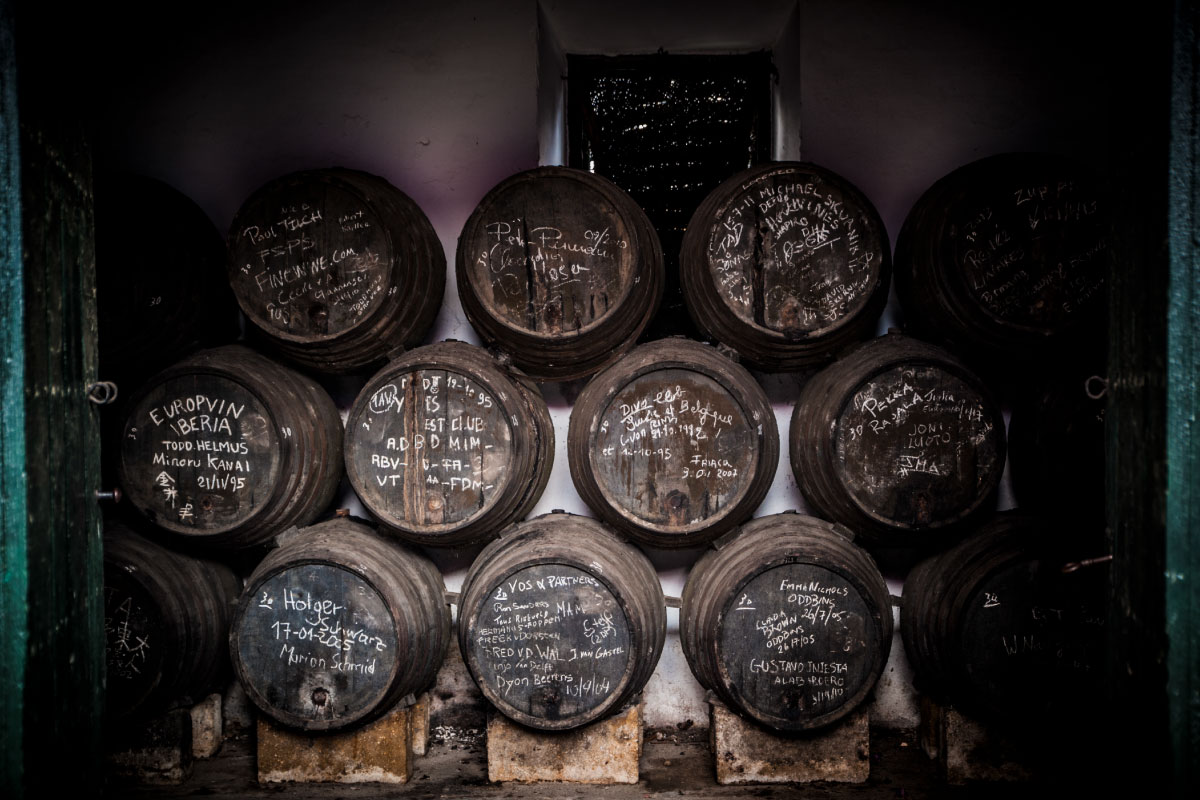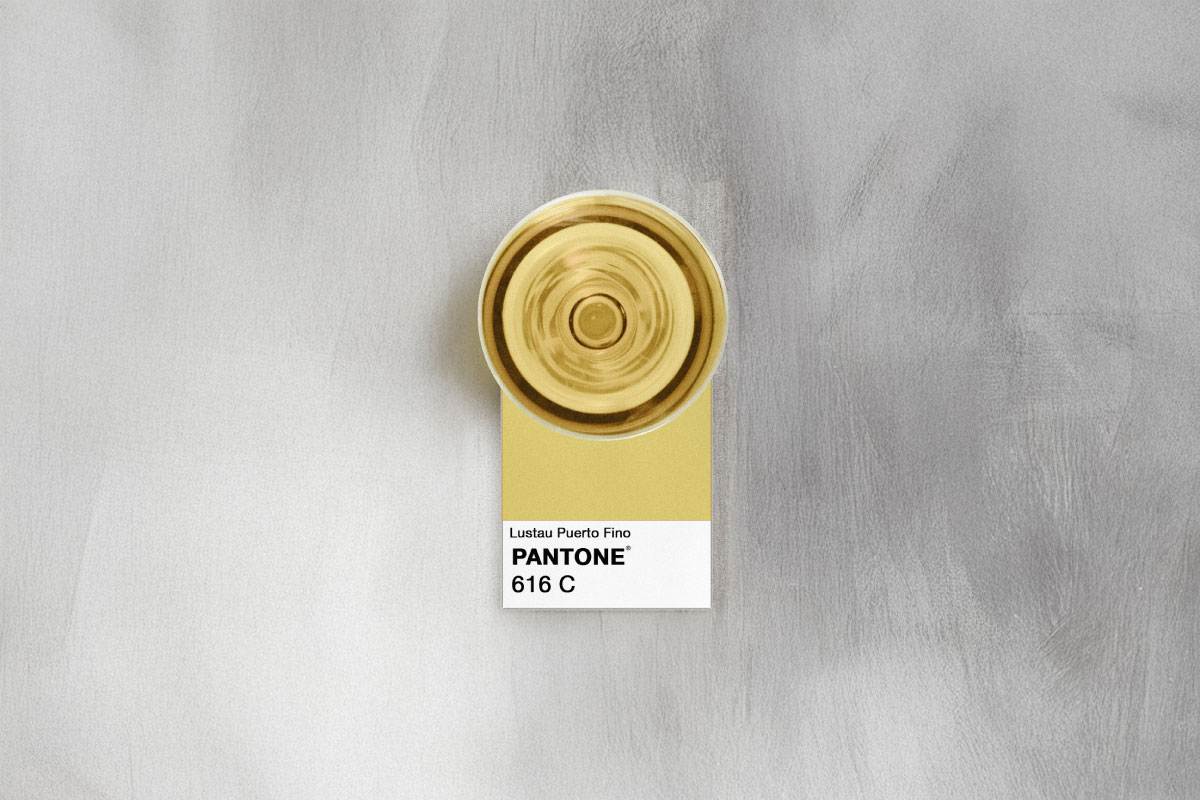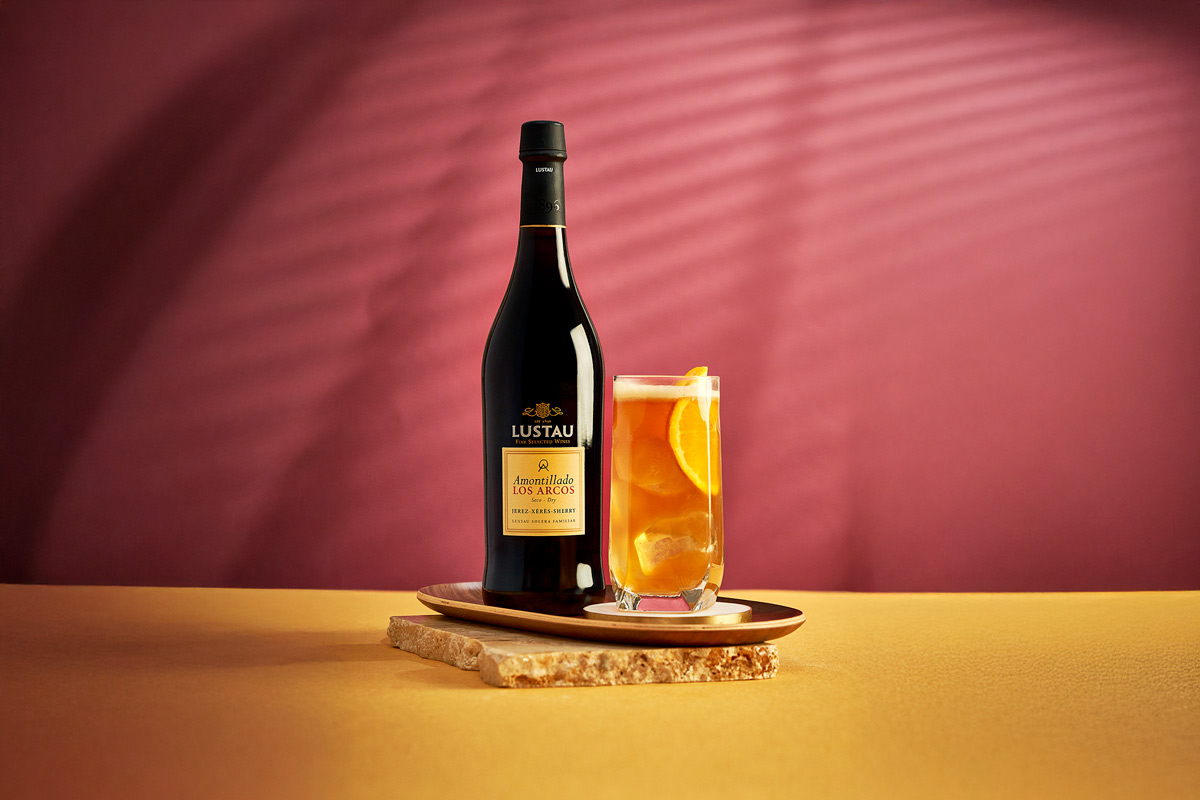Fino is probably one of the lightest and driest wines not only of the sherry region but of the wine world too. Born thanks to the indigenous layer of yeast known as “flor”,, and aged in the traditional solera system, fino is a vital wine style that is widely enjoyed and recognized by many cultures, countries and wine consumers. Find in this guide post answers to questions like what is a sherry fino by tracing its history, crafting, the role of the solera system, the “flor” and tasting profile.
You can deepen your knowledge about this wine by learning more about how sherry wines are generally aged and what is the actual role of the “flor” in this wine style.
THE ORIGIN AND HISTORY OF SHERRY FINO
Despite sherry’s long and deep history, the origins of fino sherry trace back just about a century and a half, evolving alongside the most recent cultural and industrial transformation of the region. Historically, the discovery and development of biological aging — the technique that defines fino — marked a turning point in the classification of sherry diversity and spectrum.
19th century, the establishment of a formal classification system allowed bodegas to identify and classify those wines that naturally developed a layer of “flor”, the biological veil of yeast, that both protects and shapes fino’s singular character.
THE EVOLUTION OF FINO SHERRY IN JEREZ
The emergence of biological aging marked a pivotal moment in the history of sherry and particularly for the birth of fino and manzanilla. This discovery occurred in Sanlúcar de Barrameda in the late 18th to early 19th century, when winemakers and capataces noticed a natural white film forming on the surface of certain casks. This veil — later identified as “flor” yeast — protected the wine from oxidation and transformed its character, resulting in a lighter, fresher, and more delicate profile than the traditionally oxidized styles like oloroso.
While the phenomenon may have occurred spontaneously in earlier centuries, it was in Sanlúcar where producers began to understand, harness, and eventually replicate the process in a controlled manner. The town’s unique Atlantic-influenced microclimate, with higher humidity and cooler, more stable temperatures, allowed for key conditions for the successful biological maturation.
This natural yet revolutionary discovery gave birth to a new category of wines — including manzanilla in Sanlúcar de Barrameda and later fino in Jerez and El Puerto — that would come to define part of the region’s identity. It also laid the foundation for the eventual and contemporary classification of sherry into biologically and oxidatively aged styles(that is more or less the same nowadays).

Sanlúcar de Barrameda, Jerez and El Puerto, three towns that embrace the aging under “flor”.
WHAT DOES FINO SYMBOL COME FROM?
The name “fino” is a Spanish word meaning “fine”. Spanish “fino” is an adjective meaning “classy” or “sophisticated,” a fitting descriptor for a wine renowned for its highly pronounced finesse, light body and delicate mouthfeel . The term has since become synonymous and a perfect representation of this aromatic and expressive style of wine.
Beyond its name, fino is always identified with a certain symbol in the cellar. Traditionally, barrels containing young palomino wine that began their life under a “flor” were marked for fino (or manzanilla, in Sanlúcar) elaboration. This act guided the upcoming aging process for that fino leading the young wine’s transition to a light, very dry and delicate style of wine.

THE WINEMAKING PROCESS FOR SHERRY FINO
The elaboration of fino is a natural, precise, and meticulous process that combines time and the action of “flor” under certain climatic conditions. Unlike other sherry styles, fino follows a purely biological path requiring very specific environmental factors, from grape selection to the aging process in the solera system each step plays a crucial role in shaping this sharp and vivid wine.
GRAPE SELECTION AND BASE WINE FERMENTATION
Like other dry wines from the Jerez region (such as oloroso, amontillado, palo cortado and manzanilla) fino is exclusively made from free run palomino grape must (“mosto yema”). The Palomino grape variety is known for its immense versatility (hence the diversity of dry sherry wine expressions) and its ability to express terroir. Palomino produces delicate yet versatile base wines offering a vast and diverse spectrum of personalities, identities.
Palomino is generally harvested in the middle of summer. After a gentle pressing with a light contact with grape’s skins the juice (known as segundo pie) undergoes fermentation, typically in stainless steel tanks, resulting in a dry, light white wine with an alcohol content of around 11-12% Abv.
FORTIFICATION AND THE PATH TO FINO
Once the wine is fully fermented and classified as ideal for biological aging, the base wine is fortified with a high quality, neutral grape spirit. The fortification process not only stabilizes the wine promoting “flor” appearing on the surface of the wine, it also enhances the “flor’s” chances of survival. The fortification level is crucial, creating a comfortable, friendly environment for the “flor”, guaranteeing a consistent interaction with the wines in the solera system.
There is a major change in the base wine when it reaches a level of 11-12% abv. It is at this exact moment when the fermenting yeast changes its metabolism and starts taking alcohol, instead of sugar, and turning into the compound known as acetaldehyde. This is how “flor” yeast survives, adapts to a hostile environment, becomes stronger and rises to the surface of the wine, looking to capture more oxygen, and eventually creating the famous “velo de flor”. From this moment the palomino base wine will be lastly fortified up to 15% abv to create an even more aseptic environment for the “flor”. The wine becomes “sobretabla” and it is ready to be part of the Solera and Criaderas system.
AGING IN THE SOLERA SYSTEM: BIOLOGICAL MATURATION
Finos (and the majority of wines in the Jerez region) are aged in the complex and labor-intensive solera and criaderas system, the dynamic aging method created in the DO centuries ago. Younger wines are progressively blended with older ones, ensuring consistency and complexity unparalleled to the rest of the wine world. The solera and criaderas system is so attached to the region, that its popular image (showing long rows of centenary casks carefully stocked) is generally the first picture that comes to mind when thinking about a sherry bodega.

THE ROLE OF FLOR YEAST IN FINO’S UNIQUE PROFILE
“Flor”, the live biofilm, establishes a direct interaction with the wine. This particular veil of yeasts metabolizes alcohol into acetaldehyde, the compound responsible for finding such amazing fresh, pungent notes in finos. However, there are more benefits of “flor” aging.
Yeasts not only consume alcohol, but they also take glycerol, oxygen, sugar, and acids contributing to an even drier, fresher, sharp personality. Besides, they will play a significant part once dead. “Cabezuelas”, the way we name the wine lees, are always kept in the barrel, going to the bottom, and releasing compounds of great importance: vitamins, proteins, etc. A wine that is remarkably complex in texture is just the consequence of a large concentration of “cabezuelas” in the cask.
THE BOTTLING PROCESS AND FINAL QUALITY CONTROL
After intensive aging— influenced by the direct interaction with the “flor”—this style of wine reaches its final stage in the cask. Capataces (sherry winemakers and foremans) assess its concentration, balance, acidity and complexity before bottling.
Some finos may be bottled straight from the cask, The finished fino is bottled with minimal or no filtration and treatment, to preserve its unique character and respect the genuineness of its identity. “En rama” wines guarantee wine’s personality can be enjoyed by anyone around the world at its most genuine, original conditions. Some other finos may showcase a bolder character, being eventually turned into amontillado.
En Rama wines are much more than wines bottled with minimal treatment. They have become wines for collectors thanks to their immense aging potential. Learn more about the revolutionary discovery Lustau made about En Rama wines.
KEY CHARACTERISTICS AND FLAVOR PROFILE OF SHERRY FINO
AROMAS, TASTING NOTES, AND MOUTHFEEL
This style is identified for its pale straw color, super dry palate, and pungent, vivid aromatic intensity. On the nose, fino generally reveals notes of fresh bread dough, roasted almonds, chalk and or delicate salinity. The influence of “flor” is evident in the wines mouthfeel too, lending a slightly tangy, green apple-like character.

Fino is very dry, crisp, and lively, with a firm structure and refreshing acidity. It exhibits a savory, slightly bitter finish, characteristic of biologically aged wines, and a persistent saline minerality — a testament to its terroir.
COMPARING SHERRY FINO TO MANZANILLA AND AMONTILLADO
When it comes to comparing dry oxidative sherry styles, fino can be placed on the driest side of the range, together with manzanilla. While both styles undergo biological aging under flor and share many similarities, manzanilla is exclusively produced in Sanlúcar de Barrameda, where the coastal microclimate imparts a lighter, more saline profile. Manzanilla tends to be more floral and delicate than fino, which is often more robust and structured.

In contrast, amontillado begins its life as a fino, aging under flor, but subsequently undergoes oxidative aging after the flor dies off. This dual aging process imparts amontillado with nutty, toasty, and deeper amber characteristics, distinguishing it clearly from the fresher, sharper profile of fino.

HOW CLIMATE AND AGING INFLUENCE FINO’S COMPLEXITY
Jerez is an inland city, the only one of the triangle formed by Sanlúcar, El Puerto and Jerez that is not in direct contact with a river or a considerable body of water such as the Atlantic Ocean. As a result, its geographical location can be identified as being on the border between an Atlantic and continental-attenuated climate (Font Tullot). Jerez, the city, has a moderate average rainfall over the last 20 years of 545 l/m. If Sanlúcar, El Puerto, and Jerez are compared here, great and influential differences will already be perceived in terms of levels of rainfall, and average humidity. The temperature is also very different since Jerez is the city with the highest average temperature in the summer (32.2ºC/ 90ºF), and the highest during the winter (17,9ºC/ 64ºF). Eastern (levante) winds can be found here at a much higher rate than southern or western winds, creating a direct contrast between Sanlúcar (strongly influenced by poniente (western winds) and El Puerto, which has an interesting rate based on a combination of both.
LUSTAU FINO COLLECTION
Lustau is respected for its diverse and versatile range of styles organized in different collections designed under certain concepts, profiles; suited for any palate. Lustau Fino collection explores different expressions of this biological wine, showcasing variations in aging, locations, and complexity.
Lustau Fino Jarana:
Lustau Fino del Puerto
Lustau 3 en Rama Fino de Jerez
Lustau 3 en Rama Fino del Puerto
Lustau Almacenista J.L.G.O. Fino del Puerto
Lustau Yodo
FOOD PAIRINGS AND SERVING SUGGESTIONS FOR SHERRY FINO
Fino culinary applications can be as varied as exciting. Due to its crisp acidity, very dry palate, and umami-rich character, fino is an ideal companion for a broad range of cuisines, flavors and textures.
This style of wine should be served chilled, ideally at a temperature of 7–9°C (44-48°F) to enhance its aromatic personality. Use a white wine glass, with a proper bowl, to allow the wine to breathe and express its aromatics.
PAIRINGS & CULINARY APPLICATIONS
Fino’s lively expressiveness extends beyond the dining table or the cocktail glass, making it a perfect wine for a variety of occasions and moods. Its unparalleled light and vivid personality allows it to shine as a sophisticated wine to pair with raw fishes or the base ingredient in a low abv cocktail version like a G&T. Ideal for big social gatherings, fun moments, or even as a pairing with music—think calypso, Caribbean world, ragtime, easy classical—it invites you to explore its genuineness in any context.
Whether savoring it with food, enjoying it as part of a self-crafted cocktail, or sipping it during a quiet evening of watching your favorite show, fino transforms every moment into an experience of refined indulgence.
And for those looking to explore creative and unexpected pairings, discover how Lustau Fino collection creates a twist in sensations with everyday dishes (or some other more suited to a self-treat) with these inspiring combinations. Click on the visuals to discover more about the pairing and cocktail ideas!
BEST COCKTAILS WITH SHERRY FINO
Fino’s vibrant acidity and umami character also make it a compelling ingredient in cocktails.
FREQUENTLY ASKED QUESTIONS ABOUT SHERRY FINO
What Makes Fino Different from Other Sherry Styles?
Recent insights reveal that well-crafted finos, contrary to prevalent discourse that this wine style should be consumed shortly after bottling to preserve its fresh and flor-driven character, can develop greater complexity and depth with bottle aging especially for those bottled en rama. The minimal intervention allows the wine to evolve in the bottle, transitioning from its initial vibrant and saline profile, to a richer more nuanced expression over time…,
Can Fino Be Aged Further After Bottling?
Contrary to traditional advice suggesting that this wine should be consumed shortly after bottling to preserve its fresh and flor-driven character, recent insights reveal that well-crafted finos, especially those bottled en rama, can develop greater complexity and depth with bottle aging. The minimal intervention allows the wine to evolve in the bottle, transitioning from its initial vibrant and saline profile to a richer, more nuanced expression over time. As the “flor” influence diminishes, the wine may exhibit characteristics reminiscent of amontillado, with enhanced notes of dried fruits, nuts, and herbs.
This evolution is not indicative of spoilage but rather a transformation that offers a different, yet equally enjoyable, tasting experience. Some en rama finos have been noted to age gracefully for several years, gaining complexity and a rounder mouthfeel.
What Are the Best Ways to Enjoy Sherry Fino?
Fino’s vibrant character makes it a versatile companion for various occasions. Its crisp, saline profile pairs excellently with raw seafood dishes like sashimi or ceviche, and it serves as a refined base for low-ABV cocktails, such as a Fino & Tonic or a Bamboo. Beyond the dining table, Fino complements social gatherings and even musical experiences—think calypso, Caribbean rhythms, or light classical tunes—enhancing the ambiance with its lively essence.
Is Fino a Dry or Sweet Sherry?
Fino is unequivocally dry, containing less than 1g/L of residual sugar. It is one of the driest style of sherry wine (together with manzanilla), ideal for those who prefer crisp, savory wines.







